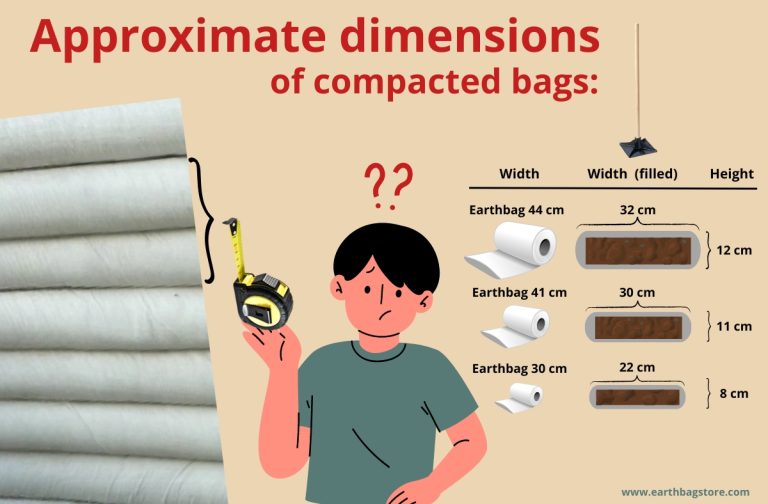Dimensions of Compacted Earthbags for Superadobe Construction

Many of you frequently inquire about the dimensions of bags after filling them with clay and compacting them manually so that you can subsequently order the required quantity of material from our online store. In this blog post, we will delve into the dimensions of these bags after being filled with clay, examining their width and height.
We offer three types of earthbags:
- 30cm Earthbag:
- After filling, the 30cm earthbag measures approximately 22cm in width and 8cm in height. This bag is known for its compactness, making it an ideal choice for constructing walls that require a lower profile. The reduced width and height contribute to a sturdy construction, minimizing material consumption. Ideal for small garden structures such as raised beds and garden seating.
- 41cm Earthbag:
- The 41cm earthbag expands to around 30cm in width and 11cm in height after filling. This mid-range option strikes a balance between stability and versatility. Its wider profile makes it suitable for constructing walls that demand more substance, providing additional strength without compromising on eco-friendliness. Suitable for superadobe house construction, retaining walls, etc.
- 44cm Earthbag:
- The largest of the three, the 44cm earthbag widens to approximately 32cm in width and 12cm in height after filling. This earthbag is perfect for projects where a robust structure is required. The increased width and height offer enhanced stability, making it suitable for larger superadobe constructions. Ideal for superadobe houses.
Advantages of Earthbags in Superadobe Construction:
- Affordability:
- Earthbags are often filled with locally sourced materials, such as clay or earth, making them an economical choice for construction projects. The affordability of earthbags allows for cost-effective and sustainable building practices.
- Environmental Sustainability:
- Utilizing earthbags promotes sustainability by reducing the demand for traditional construction materials such as concrete and bricks. Earthbags are eco-friendly and contribute to a lower carbon footprint in the construction industry.
- Adaptability:
- The variety in earthbag dimensions allows builders to tailor their construction projects to specific needs. Whether constructing a small dwelling or a larger commercial space, the availability of different earthbag sizes ensures adaptability to diverse architectural requirements.
Conclusion:
Earthbags have emerged as a noteworthy player in sustainable construction, especially in the context of superadobe buildings. Their dimensions after filling with clay—whether compact 30cm, balanced 41cm, or robust 44cm—offer builders a spectrum of choices to meet the demands of their projects. As the construction industry continues to evolve towards eco-friendly practices, earthbags stand out as a versatile and environmentally conscious building material, proving that strength and sustainability can indeed go hand in hand.


